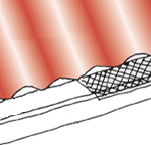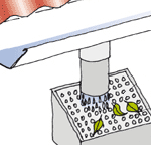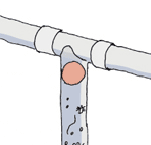Water
Water use, sustainability, and efficiency by choosing quality systems and materials, and providing environmentally friendly solutions.
Harvesting rainwater
It is crucial to ensure that the roof, guttering, pipes and other elements used in rainwater collection do not contaminate the water before it goes into the storage tank.
On this page:
- Roofing materials
- Roof paint
- Gutters and downpipes
- Leaf screens and guards
- Diverters
Water from roofs can be contaminated by decaying vegetable matter such as leaves, petals and pollen; droppings from birds, possums and rats; and dead birds, animals and insects.
Other sources of contamination include particulates from solid fuel flues; pollution; chemical spray drift; and harmful elements such as lead in the roofing material, paint, gutters and downpipes.
The Building Code requires that water supplies be protected from contamination. See Water supply for general Code requirements, and Mains or rainwater for requirements relating to rainwater collection.
To reduce the risk of contamination:
- Specify roofing, spouting and pipework materials that are safe for collecting rainwater.
- Specify leaf guards over the gutters and leaf screens on downpipes.
- Specify a first flush diverter to prevent the first 20–25 litres of water, which will be the most contaminated, from entering the storage tank.
- Do not collect rainwater from a roof that has many overhanging branches – this will reduce the risk of leaves and bird droppings getting into harvested rainwater.
- Ensure that the flue from a solid fuel burner is located so that soot and other discharges are carried clear of the rainwater collection area.
- Advise owners that gutters must be kept clean.
If rainwater is being harvested for human consumption, roofing, spouting, downpipes and pipework materials must comply with AS/NZS 4020:2018 Testing of products for use in contact with drinking water.
Roofing materials
Roofs suitable for water collection for human consumption include:
- unpainted zinc/aluminium-coated or galvanised steel
- factory-coated or painted zinc/aluminium alloy-coated or galvanised steel
- zinc
- stainless steel
- aluminium
- concrete or terra cotta (clay) tiles
- copper
- PVC (without lead stabilisers) or fibreglass sheet
- untreated timber shingles (usually imported western red cedar)
- butyl rubber
- asphalt shingles.
When specifying materials, while the first consideration is health and safety, you may want to take account of sustainability considerations such as embodied energy. See the section on Materials for more information.
Leave a new roof for at least one good period of rainfall before connecting the downpipe to the storage tank.
Do not use collected water for drinking if it has come into contact with:
- uncoated lead flashings (lead flashings on older roofs should be coated with suitable paint)
- treated timber where chemicals leaching out might contaminate the water
- asbestos (although asbestos is no longer used in building, older fibre-cement roofing that contains asbestos should not be used for collection of rainwater).
Roof paint
Specify only roof paint that the manufacturer recommends as suitable for collecting rainwater. Do not drink water collected from roofs coated with lead-based paints, and where acrylic paint has been used, wait until the surface has been washed by a good rainfall before collecting water.
Gutters and downpipes
Materials suitable for use as gutters and downpipes where water for human consumption is being collected include:
- extruded PVC
- factory-coated zinc/aluminium alloy-coated steel
- galvanised steel
- copper (which may cause staining if the water has a low pH)
- aluminium
- polyethylene/polypropylene.
Again, while the first consideration is health and safety, you may also want to take account of sustainability considerations such as embodied energy.
Leaf screens and guards
Leaf screens located on each downpipe keep larger debris out of the rainwater tank.
Diverters
These devices divert the first rain away from the water collection tank, washing dust, leaves and other debris off the roof before water is collected.
One form of diverter has a float that rises as the rainwater flows in. When the floater reaches the top of the diverter pipe, it seals it off allowing the rainwater to flow into the tank.
Generally, the more water that is diverted, the better/cted water. To calculate the amount of water to divert, consider the level of the pollutants on the roof:
- for minimal pollution, allow 20 litres/100 m2 (0.2 litre/m2) of roof area
- for heavy pollution, allow 50 litres/100 m2 (0.5 litre/m2) of roof area.
Updated: 20 May 2020




